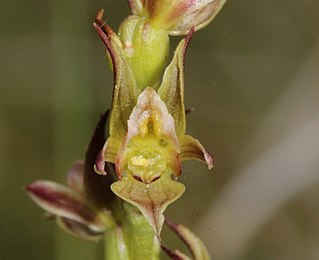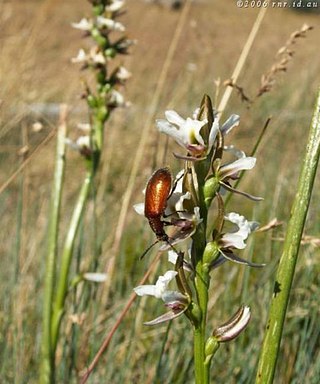Prasophyllum pyriforme, commonly known as the graceful leek orchid is a species of orchid species endemic to eastern Australia. It has a single tubular leaf and up to fifty greenish flowers with a pink or white labellum. As with others in the genus, the labellum is above the column rather than below it.
Prasophyllum concinnum, commonly known as the trim leek orchid, is a species of orchid endemic to Tasmania. It has a single tubular leaf and green or yellowish-green flowers with brown markings. It was not seen after 1947, presumed to have gone extinct and listed as "rare" under the Tasmanian Government Threatened Species Protection Act 1995 but was rediscovered in 1992. Flowering of this orchid is dramatically stimulated by summer fires and the species is now known to be widespread in the state and has been removed from the Act.
Prasophyllum erythrocommum, commonly known as the tan leek orchid, is a species of orchid endemic to Victoria. It has a single tubular green leaf and up to thirty small, greenish-brown to dark brown flowers. It is a very rare orchid, only known from a single small area north of Melbourne.
Prasophyllum fosteri, commonly known as the Shelford leek orchid, is a species of orchid endemic to a small region of Victoria. It has a single tubular green leaf and up to twenty five green to reddish-brown flowers. It is a very rare orchid, only known from a single population on a roadside.

Prasophyllum frenchii, commonly known as the maroon leek orchid or swamp leek orchid, is a species of orchid endemic to south-eastern continental Australia. It has a single tubular green leaf and up to sixty five green, reddish-brown or red flowers. Formerly more widespread, it is now confined to seven populations containing a total of fewer than 1,000 plants.

Prasophyllum fuscum, commonly known as the slaty leek orchid or tawny leek orchid, is a species of orchid endemic to a small region of New South Wales. It has a single tubular green leaf and up to thirty greenish brown to reddish brown flowers. There is debate about the taxonomy of the species with some authorities considering Prasophyllum uroglossum as a separate species. Only about twenty five plants are known to survive in south-western Sydney.
Prasophyllum gilgai, commonly known as the gilgai leek orchid, is a species of orchid endemic to Victoria. It has a single tubular green leaf and up to twenty greenish brown, light brown, pink or white flowers. It is a very rare orchid with a population of fewer than fifty plants in a small area in the north of the state.
Prasophyllum hygrophilum, commonly known as the swamp leek orchid, is a species of orchid endemic to Victoria. It has a single tubular green leaf and up to thirty greenish brown, pink or mauve flowers. It is a rare orchid only known from two populations and is classified as "endangered" in Victoria.

Prasophyllum maccannii, commonly known as the inland leek orchid, is a species of orchid endemic to Victoria. It has a single tubular green leaf and up to forty green, greenish-pink or brownish flowers. It is found in the central-west of the state, growing in open forest.

Prasophyllum morganii, commonly known as the Cobungra leek orchid, is a species of orchid endemic to a small area in Victoria. It has a single tubular leaf and up to eighty greenish flowers with purplish markings. Before being rediscovered in 2020, the plant had last been seen in 1933 and was presumed extinct.
Prasophyllum niphopedium, commonly known as the marsh leek orchid, is a species of orchid endemic to a small area in Victoria. It has a single tubular leaf and up to twenty greenish flowers with reddish markings. It is only known from five population on grassy alpine plains with the total number of individual plants less than five hundred.
Prasophyllum pallidum, commonly known as the pale leek orchid, is a species of orchid endemic to a south-eastern South Australia. It has a single tubular leaf and up to thirty green or yellowish-green flowers. It was previously thought to occur in Victoria but records from that state are now recognised as P. roseum.
Prasophyllum parviflorum, commonly known as the slender leek orchid, is a species of orchid endemic to eastern Victoria. It has a single tubular leaf and up to thirty greenish-brown to purplish flowers. Further studies of the species may indicate that some collections currently included may be of a different species.
Prasophyllum perangustum, commonly known as the Knocklofty leek orchid, is a species of orchid endemic to Tasmania. It has a single tubular, dark green leaf and up to fifteen greenish or light brown flowers with a white labellum. It is a very rare orchid with only six plants recorded in 1993.
Prasophyllum readii, commonly known as the Streathem leek orchid, is a species of orchid endemic to Victoria. It has a single, tubular leaf and up to twenty five scented, greenish-brown to reddish-brown flowers with a white or pinkish labellum and is only known from a swamp in the south-west of the state.
Prasophyllum robustum, commonly known as the robust leek orchid, is a species of orchid endemic to Tasmania. It has a single tubular, green leaf and up to thirty greenish-brown flowers with a white labellum. It is only known from a single population of about fifty plants, its numbers having been reduced by land clearing.
Prasophyllum spicatum, commonly known as the dense leek orchid, is a species of orchid endemic to southern mainland Australia. It has a single tubular, green leaf and up to fifty brownish and white or greenish and white flowers crowded in a cylinder-shaped spike.

Prasophyllum subbisectum, commonly known as the Pomonal leek orchid, is a species of orchid endemic to Victoria. It has a single, thin tubular leaf and up to fifteen small, greenish-brown to brown flowers well-spaced along a thin flowering stem. It is only known from a small area around Stawell.

Prasophyllum suttonii, commonly known as the mauve leek orchid, Mount Buffalo leek orchid or Buffalo leek-orchid, is a species of orchid endemic to the Australian Alps. Some authorities list the species as being a Victorian endemic now extinct whilst others list is as occurring in New South Wales and extant. Descriptions of the species also differ. It has a single tube-shaped leaf and up to thirty five white flowers with purple or mauve marks.
Prasophyllum uvidulum, commonly known as the summer leek orchid, is a species of orchid endemic to Victoria. It has a single, tubular leaf and up to twenty five scented, pale green flowers with reddish markings and is only known from a swamp in the north-east of the state.






